- Newsletter Issue Number:
- AICCM National Newsletter No 162 December 2023
ICS Canberra
Fred Ward Furniture Collection
Doug Rogan, Mei Wilkinson, Adelaide Butler, Cristiane Prado and the team from Patinations undertook a full assessment of the Australian National University’s original collection of Fred Ward furniture in October and November. Fred Ward become Head of the ANU Design unit in 1954 and designed many of the University’s pieces of furniture. After the 2019 hailstorm in Canberra, the furniture pieces were placed into storage for safekeeping. The whole collection is now being given full condition reports so that the next stage of treatment options can be devised.

Fred Ward furniture

Fred Ward furniture being inspected.
Old Parliament House
Karen Wilcox, Richard Issacs, Isabelle Waters, Issy Legg, Mei Wilkinson, Toni Sampson and Kristina Taylor worked in the Old Parliament House Chamber of Representatives to conserve furniture and provide other internal finishes.
Conferences
Doug Rogan was on the organising committee for the recent AICCM conference held in Canberra, and enjoyed working with the committee in the lead-up to a very successful conference.
National Library of Australia
Staffing
In August we welcomed Maren Innes for a short-term contract to work on the Overseas Rare Book Project. Welcome Maren!
We were thrilled that our Cheryl Jackson received an AICCM Medal for her 40 years of dedicated work. As one of Australia’s leading photographic conservators, she has cared for countless collections, mentored conservation students across Australia and built strong networks across the world. The Collection Care team, the collection, the Library and the Australian public benefit from her skills and experience every day, as will users of national collections well into the future. Congratulations Cheryl!
Key achievements
- Moving back into our permanent lab! For 2.5 years we have been in a temporary laboratory space. We had missed the lake views, running water, deionised water on tap and multiple fume hoods so are very grateful to be back in our space.
- Preparing a selection of chromogenic and Cibachrome prints relating to Mardi Gras by William Yang for display in our Collections-in-Focus gallery in December.
- Installing Ellis Rowan collection material on loan to Cairns Art Gallery.
- Working on new acquisitions including a rare portrait miniature of Sir Thomas Brisbane and the Journal of a voyage from Brest to Siam in L’Oiseau, 1687–1688.
- Treating and stabilising more than 3,200 items for digitisation, and completing projects such as the Papers of Bobby and Gracie Le Brun, which can now be viewed online through Trove.
- Completing stabilisation treatment on more than 1,300 volumes and rehousing more than 1,600 volumes as part of our Overseas Rare Book Project.
- Reaching completion of the Roof Replacement Project. We continue to work closely with the Facilities and Capital Works team on the replacement of all the windows and upgrade of the HVAC system.
- Inputting into a Building Master Plan and plans for how the Library will get to net zero by 2030.

The NLA Collection Care team in our new/old lab. From left to right (front to back) – Maria Genetzakis, Jacinta Sanders, Lucilla Ronai, Janet McDonald, Nicki Smith, Lisa Jeong-Reuss, Cheralyn Lim, Caroline Milne, Cheryl Jackson, Maren Innes, Adele Barbara, Aurelie Martin (not pictured: Tania Riviere, Nicole Rowney).
We are all looking forward to our Christmas party and upcoming break.
Chau Chak Wing Museum, The University of Sydney
In mid-November, Chau Chak Wing Museum (CCWM) conservators Kerry Head, Kerry Etherington and Madeleine Snedden attended the AICCM National Conference in Canberra with three days full of interesting papers, catch-ups, and insights into current conservation practices.
Treatment projects
A changeover of the Ornithology section in our Natural Selections exhibition led to the cockatoos taking a well-earned rest and the pigeons and doves of all shapes and sizes taking their place. Kerry Etherington has been working on the conservation of these historic specimens. A tiny articulated wonga pigeon skeleton (Leucosarcia melanoleuca), dating from the 1880s, was gently cleaned to remove significant dirt depositions and to repair structural damage, accumulated during many years of inadequate storage. Using a lot of tiny toothpick swabs and micro-brushes, the treatment required a steady hand, steady nerves and a lot of breath holding!
![NHB.1887; Skeletal specimen; Leucosarcia picata [melanoleuca] (Latham); New South Wales, Australia. Image credit: K Etherington.](https://aiccm.org.au/wp-content/uploads/2023/12/Image-1-400x533.jpeg)
NHB.1887; Skeletal specimen; Leucosarcia picata [melanoleuca] (Latham); New South Wales, Australia. Image credit: K Etherington.
Years’ worth of dust was removed from the wafer-thin bones, rendering them translucent again, and the skeleton was reunited with its various parts: a broken leg, foot and ribs. Each part was stabilised with tiny tinted Japanese tissue paper repairs. Finally, the insertion of some silicone mesh inside the skull prevented the head from twisting about, and the skeleton was put on display.

NHB.1887, during treatment, cleaning of surface dust from bone. Image credit: K Etherington.
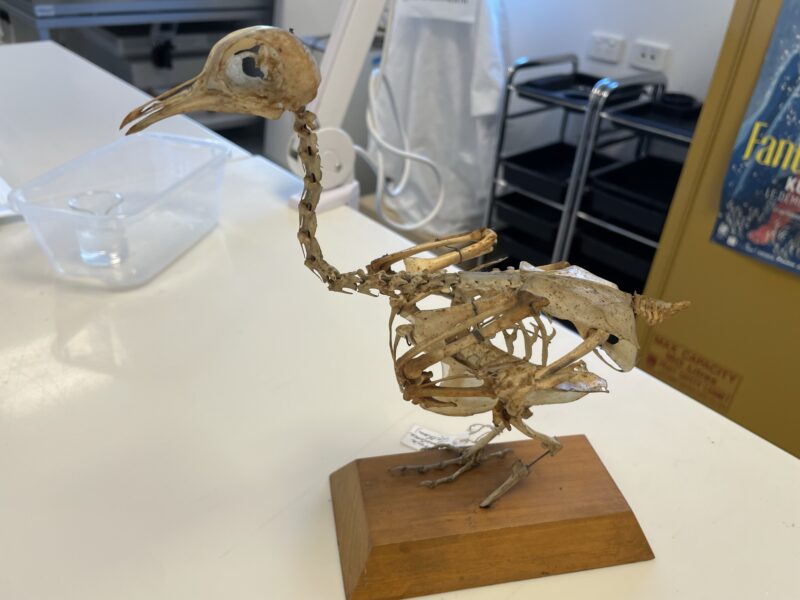
NHB.1887, before treatment, broken PL leg and foot. Image credit: K Etherington.
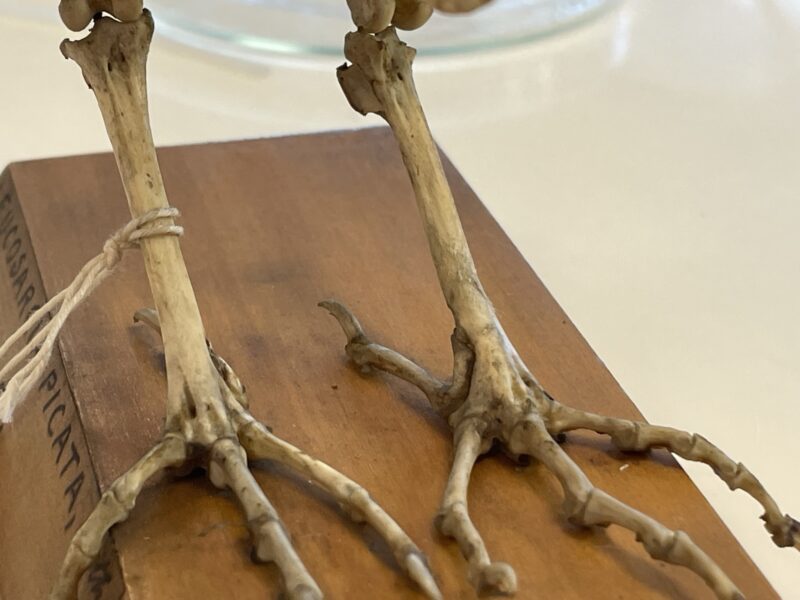
NHB.1187, after treatment, repaired PL leg and foot. Image credit: K Etherington.
Exhibitions
In early September, a large exhibition changeover took place in our Level 3 Gallery space. It began with the de-installation of Object/Art/Specimen, an opening exhibition for the CCWM, that had been on display since 2020. Object/Art/Specimen was an exhibition highlighting different themes within the CCWM collections. Over 500 objects and specimens were de-installed, from a limestone sarcophagus and a mounted thylacine specimen to plant fibre baskets and hundreds of entomology specimens. The de-installation involved a lot of pre-planning (and object lists!) to carefully pack, quarantine, relocate and return objects, artworks, and specimens back to storage.
Tidal Kin exhibition opened in October in place of Object/Art/Specimen. Its focus is reclaiming the stories of eight Pacific Islander visitors to Sydney during the 18th and 19th centuries. Objects for display include Pacific objects from the University’s Macleay Collections, private loans, and the loan of a 19th century plant fibre poncho from the Powerhouse Museum. In addition is the display of a now-extinct Huia (Heteralocha acutirostris) bird skin from Aotearoa New Zealand, also part of the Macleay Collections. We all spent months re-acquainting ourselves with the vast Pacific collection and of course the Huia skin. Many hours were dedicated to condition reporting, conservation treatments, collaborating with the fabulous Kevin Bray (our contract mount-maker) and installing with our amazing exhibition preparators.

Kerry Head, Madeleine Snedden and preparators Lionel Baldwin and Szymon Dorabialski installing objects for Tidal Kin. Image credit: L Parker.
We have had a very busy few months with many more changeovers in our exhibition spaces. These include a new Ornithology display; a new display of ancient Greek artefacts and lantern slides all about the olive and the olive tree; a new display of photographs by First Nations photojournalist Aunty Barbara McGrady; and, finally, a film installation in our contemporary art space, Nyctinasty, by First Nations artist Hayley Millar Baker.
Campus loans
As conservators at a university museum, it is our responsibility to care for museum collections on display across campus.
One such project is the new display of artworks for the University’s Business School. The paintings chosen by the Dean of School, the CCWM Director and curatorial staff include newly acquired works and existing paintings from the art collection. Paintings by over 20 female First Nations artists have been condition reported, treated, and framed and/ or glazed prior to installation and display in December 2023.
Another project undertaken in November was the maintenance and care of the sculpture Spine 1 (universe) (UA2018.25.1) by Indigenous artist D Harding. Kerry Head spent a day up an elevated work platform removing dust, cobwebs, and insect frass from the pigmented elements of the sculpture, which is installed in the Life, Earth, and Environmental Sciences Building on Sydney Uni campus.
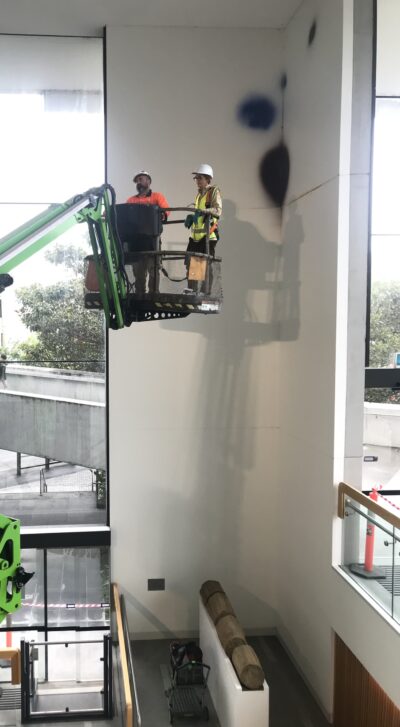
Kerry Head up the elevated work platform caring for Harding D, 2018, Spine 1 (universe) (UA2018.25.1). Image credit: V Ho.

Kerry Head up the elevated work platform cleaning the walls around the pigmented areas of Harding D, 2018, Spine 1 (universe) (UA2018.25.1). Image credit: V Ho.
ICS New South Wales
ICS conservators from across Australia have had an extremely busy national and international conference season in recent months, both through attendance and ICS sponsorship.
In September, Julian Bickersteth, Matteo Volonte, Alis Jitarescu and Katie Smith attended the ICOM-CC Conference in Valencia, where Julian presented a paper on learnings from the Lismore floods and Alis, Suati Rojas and Katie Wood presented posters.
Also in September, Julian Bickersteth, Richard Silink and Jo Roberts attended the ICOMOS General Assembly 2023. Speakers from around the world gathered to discuss the pressing need for action to mitigate the impact of climate change, not only on our environment but also our cultural heritage.
Claire Rowson attended the WA State Heritage Conference in October, where Lily Bennion, Assistant Curator, Fremantle Prison, presented a paper about the ICS mural conservation work at Fremantle Prison.
In November, seven ICS staff members enjoyed the excellent AICCM 50th anniversary conference in Canberra. Julian Bickersteth presented on behalf of ICS as conference Premier Event Partner, on ‘Action in the face of climate change—what conservators can do’. Adam Godijn, Head of Conservation, Fine Decorative Arts, led a presentation on ‘Mould, a growing issue. Past, present, future. Sharing in-house research’. And on behalf of Amy Walsh, Julian Bickersteth presented ‘Shining a light on collaboration: relocating the South Solitary Island Lighthouse Optic’.
With a view to supporting the profession and promoting sector-wide action on climate change, ICS has also been a keen sponsor of recent events:
ICS was Climate Action sponsor for the ICOMOS GA2023, along with hosting an Emerging Heritage Professional (Jo Roberts) for a three-month internship to support the development of stories and profiling of speakers and topics both before and during the event.
ICS kicked off its two-year Australian Museum partnership with sponsorship of the annual Talbot Oration in April and the first of two workshops for regional galleries and museums in September, run through the AM’s Climate Solutions Centre. The Road Map to Net Zero workshop saw 20 attendees from around NSW devising practical, localised action plans for meeting the challenges of climate change on cultural heritage and collections.
ICS was a proud donor to the AICCM’s 50th anniversary fund-raising drive, and also made an additional contribution to match ICS staff donations.
ICS was especially pleased to sponsor the AICCM Conference Sustainability session, along with the golden anniversary birthday cake.
Paintings
Our Paintings Team treated a number of important oil paintings during the last few months, including six paintings from our conservation partner New England Regional Art Museum (NERAM). Claire Heasman also undertook an interesting mould remediation treatment for hollow log bark paintings.
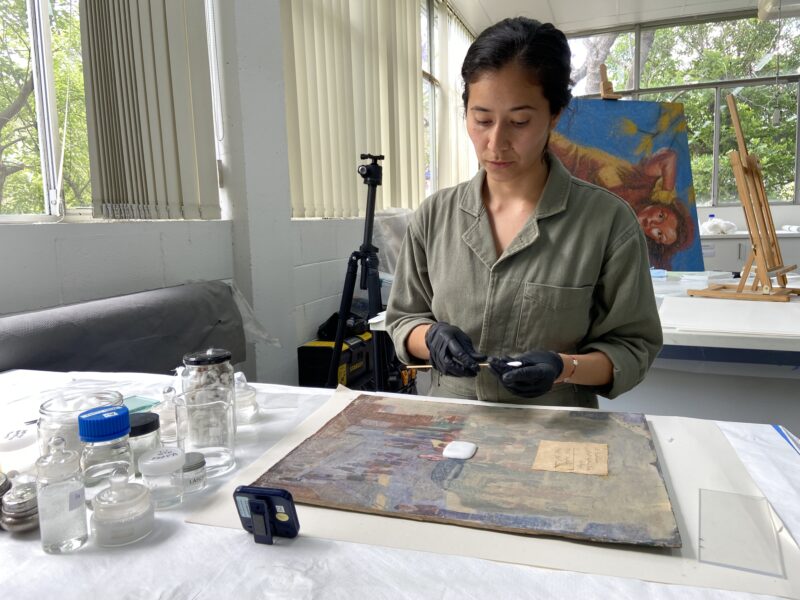
Suati Rojas working on a NERAM painting.
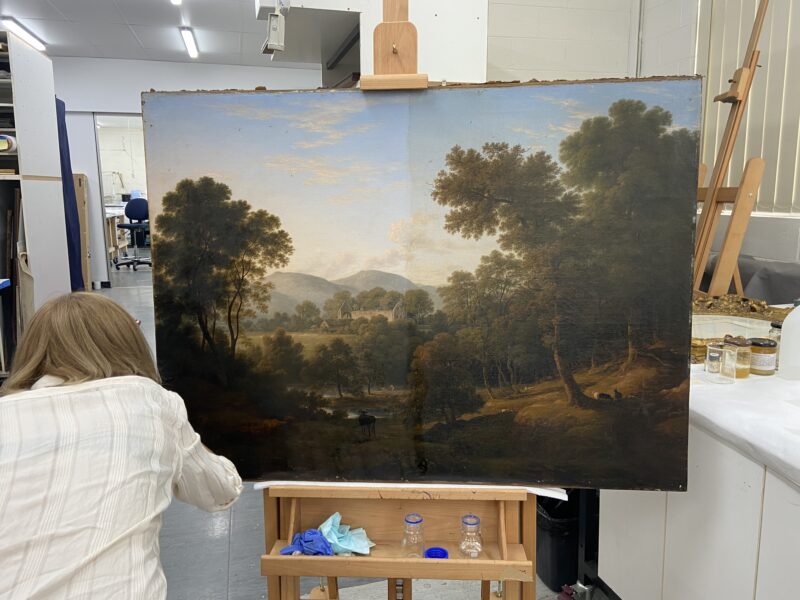
Alis Jitarescu working on a private oil painting.

Claire Heasman is working on mould remediation of hollow log bark paintings.
Textiles
Yolanda El Khouri carried out an extensive treatment on a partially burnt and charred rug, which has tremendous sentimental value for the owners. By removing charred wool pile tops she was able to re-expose the colourful wool piles underneath and preserve a much larger part of the rug than initially expected. She also completed a treatment for the Camden Historical Society, started by Bella Taylor, on a charming wool cub uniform. The uniform was badly damaged from pest infestation and required stabilisation and preparation for display in a pull-out drawer.
Christina Ritschel carried out major stabilisation on the interior silk lining of a red coat tails hunting coat for the Museums of History New South Wales.
In Canberra, Christina and Adelaide Butler reproduced lace and yellow damask curtains as part of extensive Duntroon House renovations. Due to manufacturing restrictions the exact yellow damask was not available overseas in time for our strict deadline, so instead Christina sourced and dyed the fabric in Australia. Christina and Adelaide also successfully rose to the challenge of reproducing the lace. With both fabrics beautifully replicating the original, the windows were restored to their former glory.
In October, Christina was again involved in hanging the original Coburn stage curtains at the Sydney Opera House, as part of their 50th anniversary celebration. After de-installation, the Curtain of the Sun tapestries were rehoused on new larger-diameter rollers and stored in larger crates suitable for long-term storage. The Curtain of the Moon tapestries (not displayed at the SOH this year) were also rehoused. Padded doonas were placed over the back of each curtain to facilitate a more even rolling process.
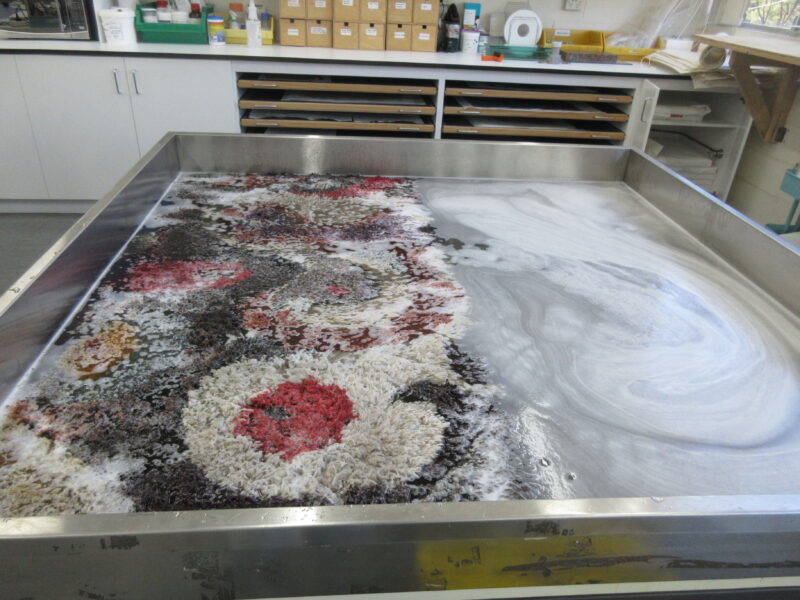
Yolanda El Khouri undertaking an extensive treatment on a burnt and charred rug.

Reproduction lace and yellow damask curtains for Duntroon House, Canberra.

Christina Ritschel was on hand at the Sydney Opera House to hang the Curtain of the Sun tapestry.
Paper
The Paper Team has recently worked on a number of Asian artworks including a beautiful six-panel floral screen, a set of four hanging scrolls, and a single panel screen depicting a black cormorant. The flowers on the six-panel screen are painted with a thickly applied white chalk medium that has accumulated surface dirt/grime and become unstable with cracks and losses. Katie Wood and Suati Rojas had great results from swab cleaning the flowers (petal by petal!) and are now in the process of consolidating the screens with funori.
The team also treated ten 19th century historical portrait miniatures belonging to a local historical society. The backing, inscriptions and labels on the miniatures had deteriorated significantly. Caroline Whitley de-framed, cleaned, and removed all ephemera, then repaired and placed the miniatures onto new backing supports.

Working on a Japanese screen.

Historical portrait miniature.
Museum and Gallery Services
Mei Wilkinson returned from a six-week internship in Hong Kong where she was the recipient of the 2023 George Alexander Foundation Fellowship from the ISS Institute. She was invited to the M+ Museum, Hong Kong’s global museum of visual culture, to work with their conservators and learn more about the growing need for innovation in conservation of time-based media. We are excited to learn more from Mei about the development of thought leadership in this area and the wide range of conservation methodologies required, many of which require a knowledge of technology.
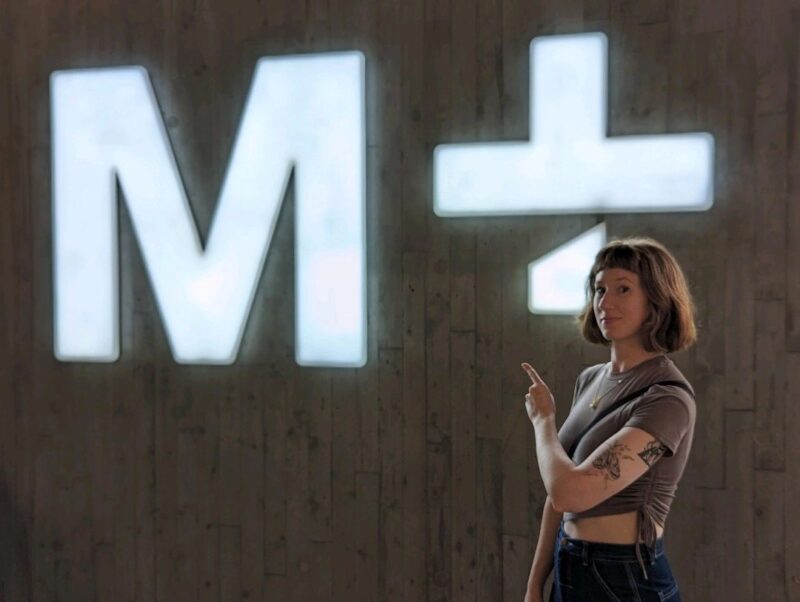
Mei Wilkinson in M+, Hong Kong.
Objects & Outdoor Heritage
Amy Walsh treated a beautiful urn by artist Simone Fraser, which had been broken into one large piece and many small pieces. The urn has a unique design and Amy managed to find and place all the pieces back together like a puzzle, bringing it back to its original complete state.

Simone Fraser urn—before treatment.

Simone Fraser urn—after treatment.
Adaminaby Trout
Karen Wilcox and Doug Rogan are bringing new life to the Adaminaby trout, one of Australia’s ‘big’ icons. The fibreglass trout, 10 metres tall and weighing 2.5 tonnes, suffered from failing paint layers and general deterioration. Our conservators conducted paint removal trials to determine the most suitable paint system, and worked to re-paint the trout with weather resistant materials with longevity. Our brief was to ensure the paint is a representative and accurate depiction of rainbow trout colours. This project is almost complete, soon to be revealed looking fresh again.
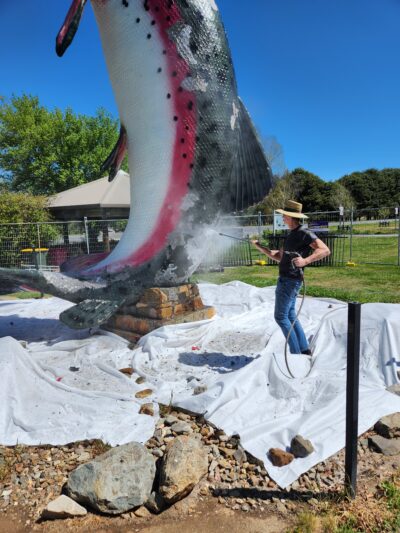
Cleaning the trout.
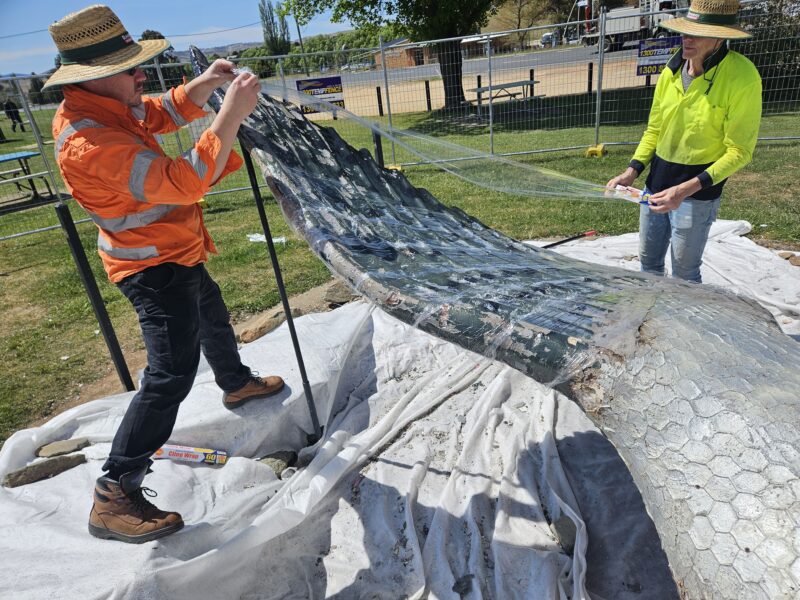
Cling wrapping the trout.
Lindy Lee—Secret World of a Starlight Ember
Kristina Taylor and Issy Legg conducted the annual maintenance on Lindy Lee’s Secret World of a Starlight Ember, a mirror-polished, marine-grade stainless steel sculpture on presentation at the front of the Museum of Contemporary Art Australia in The Rocks, Sydney. The steel sculpture is covered in holes, representing stars in our cosmos and humans’ connections to the cosmos.
Since installation in 2020, the sculpture has required regular inspections and cleaning to ensure it can be viewed as intended and is not being damaged by the proximity to salt water and passers-by.
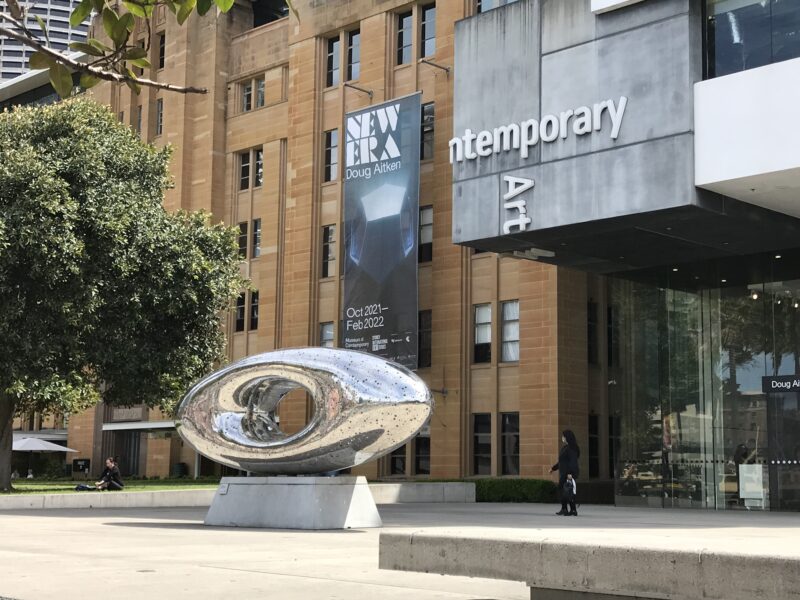
Secret World of a Starlight Ember.
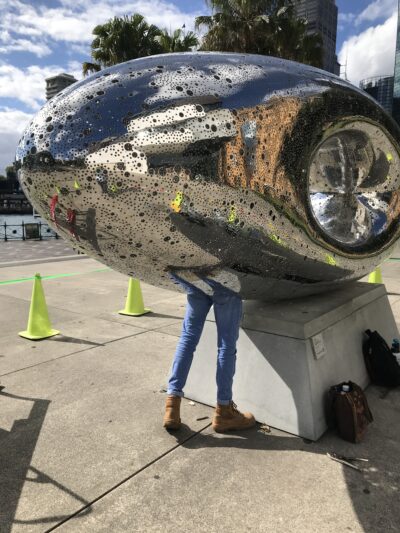
Maintenance on a Secret World of a Starlight Ember.
Hampton Court statues
Keir Bayley undertook a conservation treatment on Victorian-era lead statues originating in 18th century Kingdom of Great Britain. The statues were probably ornamental outdoor garden or roof statues once displayed in one of Britain’s many prestigious heritage properties such as Hampton Court Palace.
The statues were in poor condition and had major structural issues, and Keir’s successful treatment involved specialist knowledge and skills for working with lead. The corroding armature was replaced with a new stainless-steel armature, and missing pieces were fabricated to complete the restoration.
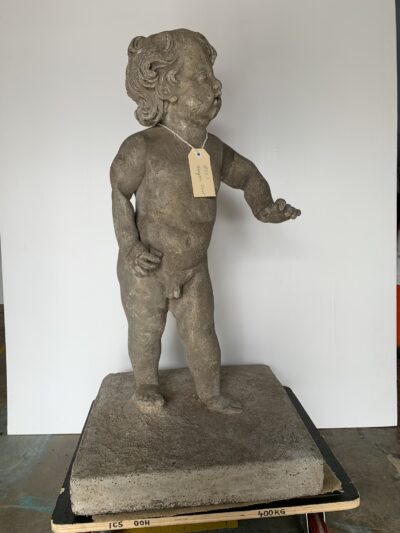
Before, Hampton Court statues.

After, Hampton Court statues.
HMAS Vampire
The Australian National Maritime Museum’s decommissioned HMAS Vampire, a Daring Class destroyer, is the largest museum vessel in Australia and was active in the Royal Australian Navy from 1959 to 1986. Isabelle Waters managed a small team dedicated to ridding the ship of dust, dirt and mould, and provided advice about ongoing preventive cleaning and maintenance.

HMAS Vampire interior.
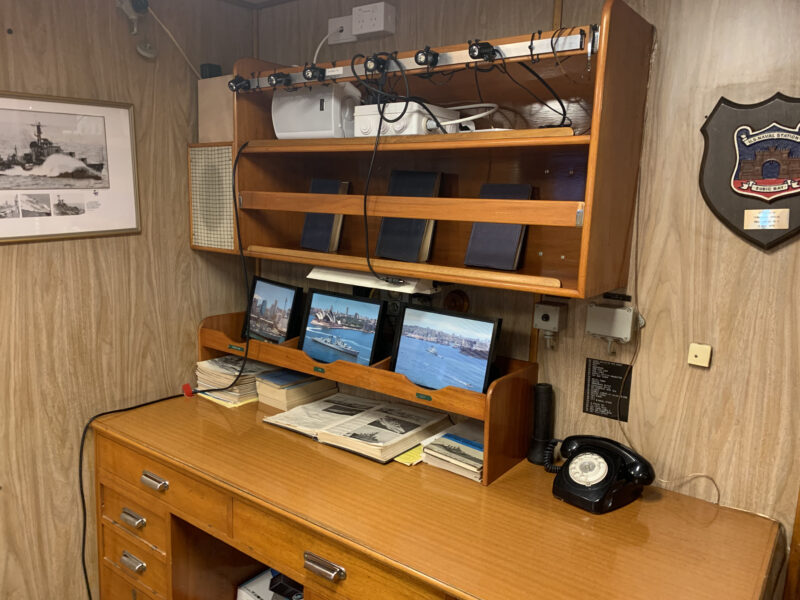
HMAS Vampire interior.
Farewell
We sadly bid farewell to Amy Walsh in November. Amy is off on a two-year placement in Scotland to deepen her skills and experience in ceramics conservation.
O’Sullivan Conservation
Staff news
O’Sullivan Conservation (OSC) has sadly said goodbye to Kimberley Chung, who is joining Sophie Brown Conservation and Framing to further her skills in paper conservation. We also sadly say farewell to Georgina Wiley, who is moving on to a position at the National Film and Sound Archive. We wish them both well in their new roles.
Emily Bramich is undertaking the Introduction to Heritage Engineering course through the University of Canberra as a part of her professional development. Emily is practising her skills in assessing significance and understanding the conservation needs of industrial heritage sites and items, including an onsite workshop at the Balls Head Coal Loader in early December.
Professional news
In November, the AICCM 50+/-50 National Conference in Canberra was greatly enjoyed by several members of the team, including Eoin O Suilleabhain, Hannah Newman and Katherine Rosenthal, with Emily also attending the awards ceremony. OSC was also proud to support the conference by sponsoring notebooks for the event.
O’Sullivan Conservation was honoured and thrilled to have been awarded the AICCM Outstanding Conservation Treatment of the Year, presented at the 2023 National Conference.
The conservation project involved the major treatment of a life-size plaster sculpture by the artist Rayner Hoff, commissioned for the Australian Museum and constructed in 1925. The model for the sculpture was a historical figure and Wiradjuri Elder, Uncle Jimmy Clements, who in 1927 made the first recorded sovereignty protest at Parliament—treatment involved complex structural repairs and cosmetic reintegration of significant breaks and losses.
We are grateful for consultations with the Australian Museum’s First Nations Collections & Engagement team and the Collection Care & Conservation team, and their initial contact with a descendant of the family, to achieve an aesthetically and culturally sensitive result. Parts of the treatment process feature in the documentary Her Name is Nanny Nellie, which recently premiered at the Adelaide Film Festival in October 2023 and will air on NITV in 2024.

The OSC team accepting the award for AICCM Outstanding Treatment of the Year 2023.
In October, Eoin and Hannah attended the NZCCM 2023 National Conference—‘Conservation in Aotearoa New Zealand: Inside and Out // Ki Roto, Ki Waho’, held at the Auckland War Memorial Museum, Tāmaki Paenga Hira. The conference included themes of community and heritage conservation, disaster response, environmental management and adapting conservation ethics to Māori landscapes.
Back at the workshop, the team undertook our regular safety training program by brushing up on our scaffold skills. The team practised assembling the mobile scaffolding (up to 3.9m) required for our onsite projects by learning safe and effective techniques from scaffold professional partners.

Eoin at the NZCCM 2023 National Conference in Auckland, New Zealand.

The OSC team undertaking mobile scaffold training.
Treatment projects
In September, OSC conducted our conservation maintenance program for several prominent outdoor sculptures in Sydney’s CBD, including the bronze statues of Queen Victoria and Prince Albert in Macquarie Street. The larger-than-life monument of Queen Victoria, positioned atop a Moruya Granite pedestal outside St James’ Church, underwent conservation treatment by Emily Bramich and Mathew Geale. The team worked on a fully enclosed three-level scaffold to reach the top of Victoria’s crown, whilst Eoin worked on Prince Albert from the safety of an elevating work platform (EWP).
The Queen Victoria monument exhibited extensive depletion of previous wax coatings, resulting in a blue patina that obscured intricate details on Victoria’s face, arms, orb, sceptre, cloak and veil. Similarly, Prince Albert’s monument exhibited a heavy blue/green patina across much of the surface, obscuring his robes of the distinguished Noble Order of the Garter. Conservation included cleaning, corrosion removal, removal of remnants of past wax coatings, and application of new protective coatings of wax for each of the monuments.
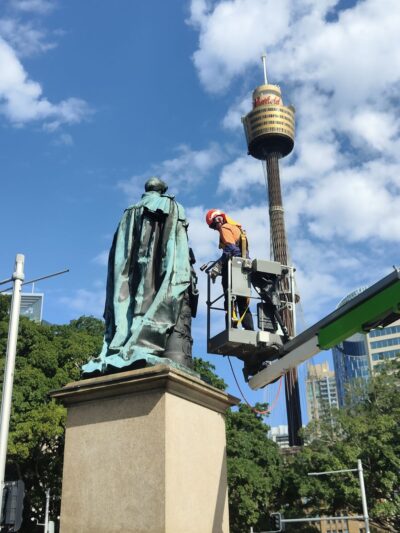
Eoin treating Prince Albert sculpture.
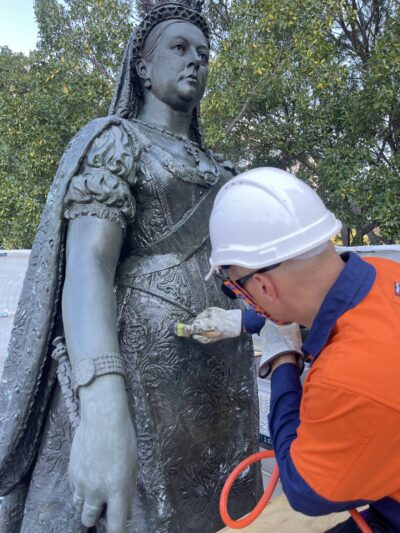
Mathew applying wax coating to Queen Victoria sculpture.

Emily applying wax coating to Queen Victoria sculpture.
OSC’s work on the Gosford Cenotaph has been completed ahead of its 100-year anniversary in April 2024. Located in Gosford Park and overlooking Brisbane Water, the war memorial was designed in 1923 by Gordon Samuel Keeling, the architect of many significant war monuments across the Western Front and Gallipoli. It was a pleasure working with Central Coast historian Merril Jackson OAM, who spear-headed the ‘Poppy Project: Never Forgetting the Sacrifices’ and the campaign for this significant memorial to be listed on the State Heritage Register. OSC was honoured to undertake the conservation treatment of the copper alloy honour rolls, plaques, insignias, wreath and lettering on the memorial.
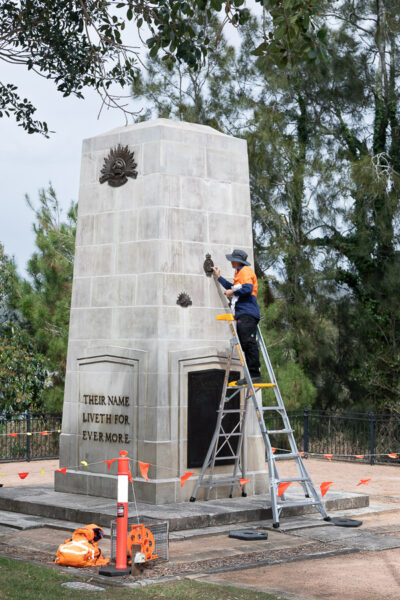
Mathew applying wax to copper alloy elements at Gosford Cenotaph.
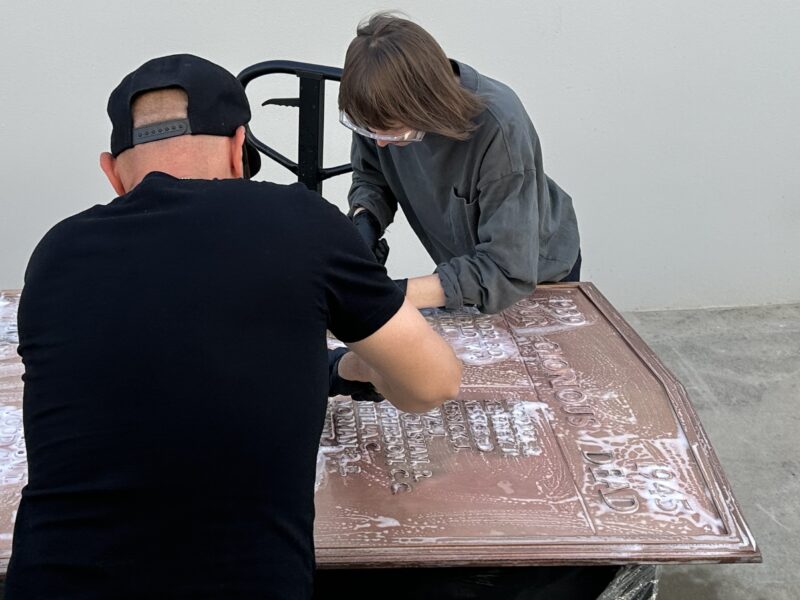
Mathew and Emily cleaning copper alloy honour rolls.
OSC has recently completed the project management of the stonework for the surroundings of bara by Judy Watson. Situated on the Tarpeian Lawn in the Royal Botanic Garden Sydney, overlooking the harbour on the eastern shore of Warrane (Circular Quay), the six-metre-high artwork carved from Carrara marble is shaped into the crescent form of the traditional ‘bara’ fishhooks of the Eora fisherwomen. OSC plays a vital role in maintaining the integrity of bara through regular condition assessments, monthly maintenance cleaning, and regular removal and reapplication of sacrificial protective coatings to safeguard the sculpture. Hannah Newman has been instrumental in overseeing the transition from wood mulch to paving surrounding the artwork, reducing potential damage arising from dirt accumulation and unintended contact.
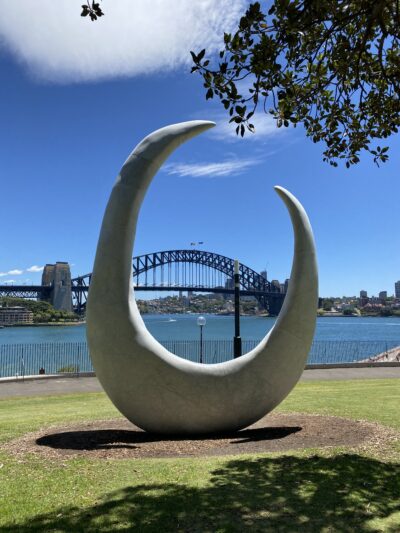
bara marble sculpture in Sydney Harbour Warrane.
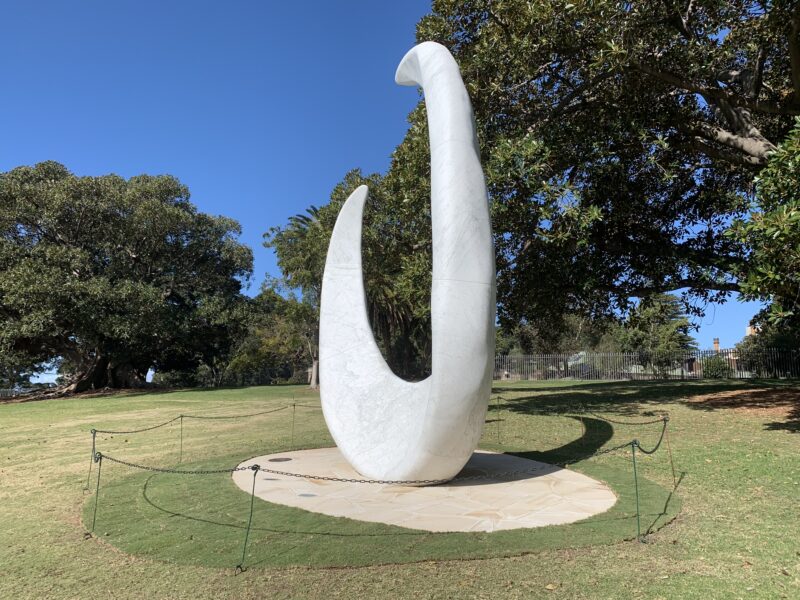
Installation of stonework paving around bara sculpture.
Emily has recently completed the treatment of a Japanese carved wood screen. The complex treatment has involved structural stabilisation, mould removal, cleaning, waxing, and inpainting to losses, as well as stabilisation of ivory, mother of pearl and bone inlay elements and replication of missing components.
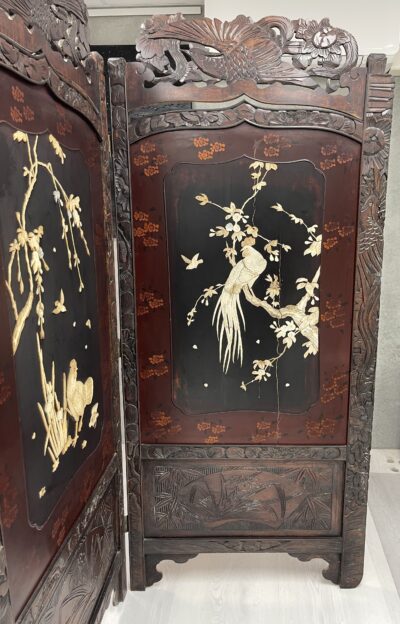
Conservation treatment of a Japanese screen.
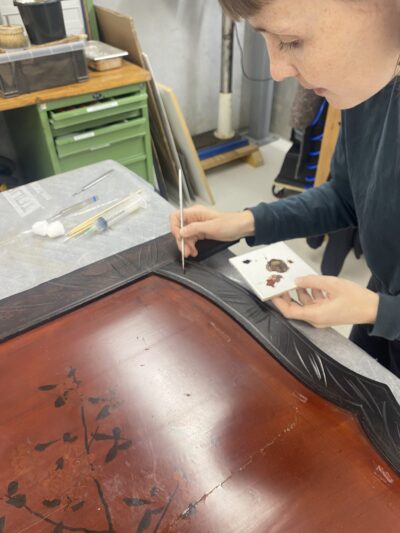
Emily inpainting losses to a Japanese screen.
State Library of New South Wales
Staff changes
The Book, Objects and Paintings team has temporarily combined with the Preservation team whilst Abigail Hundley is on parental leave. Preventive conservator Nicole Purkiss has made a welcome return from parental leave.
Professional news
The State Library has just completed another large project—the creation of a new auditorium beneath the heritage Mitchell Reading Room. This project required the relocation of significant portions of the collections to other parts of the building. Approximately half of the original storage space will be returned to collection storage, enabling us to create a dedicated objects storage space to be fitted out over the next few months.
Preservation Team
Sonia Lee has been assessing items for the next iteration of the object gallery display. There are 250 items that require assessment! Dominique Moussou has been settling into the Library routine and completing book condition reports for our high-priority items.
Dominique’s book conservation skills have also been in demand in assessing volumes for upcoming exhibitions.
The Preservation Team and Dominique have been working on one of our high priority collections for conservation—the Dixson folios. These folio-sized items are printed items (serials, newspapers, monographs) collected by Sir William Dixson and date from the 16th to 19th centuries. The team will be repairing and rehousing approximately 800 items.
New interesting collections the team has treated and rehoused recently include the Walter Carter funeral home collection, including eight ledgers with details of funerals in Sydney from the 1800s, and the Michael Bogue collection of share certificates issued mainly in NSW. The team has constructed oversized folders and boxes to safely rehouse these complex collections.
As part of Rare Book Week here in Sydney some team members visited the Penrith Museum of Printing, which is a non-profit organisation dedicated to the preservation and conservation of letterpress printing technology. The highlights were viewing the collection of fully operational printing presses from the 1840s to 1970s!
Registration
In September we received 30 Indigenous artefacts, selected by members of the La Perouse Community, for research and display in the exhibition Wadgayawa nhay dhadjan wari (they made them a long time ago).
The exhibition is part of the Mobilising Aboriginal Objects: Indigenous History in International Museums project to bring artefacts chosen by Community back to Country where they can be viewed and discussed with the aim of rebuilding knowledge about important but poorly documented artefacts from the region held in overseas collections. The project is a partnership between the Australian National University, the British Museum, Museum of Archaeology and Anthropology, Cambridge, Deakin University, La Perouse Local Aboriginal Land Council and the Gujaga Foundation. Loan fees, packing and transport costs were funded by the Australian Government through the Australian Research Council. The Library was able to facilitate and administer the loans as we are an approved borrowing institution under the Federal Government’s PCOL scheme.
The artefacts are from five UK institutions: the British Museum, Cuming Museum, Southwark Council London, Museum of Archaeology and Anthropology Cambridge, Pitt Rivers Museum, Oxford, and National Museums Scotland—and were accompanied by a courier from the British Museum who oversaw the transit, unpacking, condition checking, community consultation day, mount making and installation alongside our conservators. The lenders’ loan agreements all needed to have agreed special conditions attached to reflect the aims of the project.
We set up the community engagement day in one of our venue spaces with tables and handling notes for each artefact. Community was encouraged to handle, document and discuss artefacts. This information was documented and will be sent to the lenders to improve catalogue information. It was such an amazing experience seeing three generations of families talking about and sharing information about their living culture.
Kevin Bray spent a week with us making custom supports and the exhibition design allows the visitor to see how these artefacts are used, suspended at the height they were made for rather than flat in showcases.
It was also our first experience of virtual couriering—we set up a WhatsApp group for the installation so National Museums Scotland could see and follow the process live via their conservator in Canada and their curator in Edinburgh, and across three time zones!
Visitor response to the exhibition has been very positive. Exhibitions like this are a way of continuing dialogue between communities and institutions to look at possible long-term loans and repatriation, but this does takes time and sensitive negotiations.
Wadgayawa nhay dhadjan wari (they made them a long time ago) is in our First Nations Gallery until the end of January 2024.
Australian Museum
People and Places (Social news, Staff changes, Events, Professional news)
We bid a fond farewell to Silvia Da Rocha who is now working as an Exhibition and Museum Officer at Lake Macquarie City Council, much closer to her home near Newcastle, NSW. Silvia is a delightful person and an asset to any team, so she will be dearly missed. We wish Silvia all the best in her new role.
The team was well-represented at the AICCM National Conference this year, with most attending. We were also well-represented in the conference proceedings, presenting two talks and two posters. Sheldon Teare presented a talk on the current state of Natural Science Conservation in Australia and suggested the need for this to become a focus area in the conservation profession, especially given the realities of the climate crisis and our rapidly changing environment. Sophie Phillips presented a lighting talk on the collaborative relationships built while working alongside collection staff to install the permanent gallery, Minerals. Melissa Holt & Clare Kim presented posters on recent treatments.

Sheldon Teare presenting at the 2023 AICCM Conference in Canberra

Sophie Phillips presenting at the 2023 AICCM Conference in Canberra
At the conference we also learnt that Sheldon, along with Irene Finkelde, Dani Measday, and Kerry Etherington, were successful in their AICCM 50 Year Anniversary Grant application. They will be working to deliver Natural Science focused training in 2024.
Exhibitions
In October, the new permanent Pasifika gallery Wansolmoana opened to the public. Wansolmoana–meaning One Salt Ocean–reflects on the cultural significance between the natural environment and Pasifika people to showcase their rich stories and objects. Conservators Kyra Kim, Lizzie Reed and Melissa Holt worked tirelessly to prepare and install the objects in this new gallery for display. Some highlights include a Tokelau vaka that speaks of the climate emergency for Pacific nations, and is a centerpiece in the gallery; and a display showcasing the diversity of fish hooks across the Pacific.

Tokelau vaka in the Wansolmoana gallery
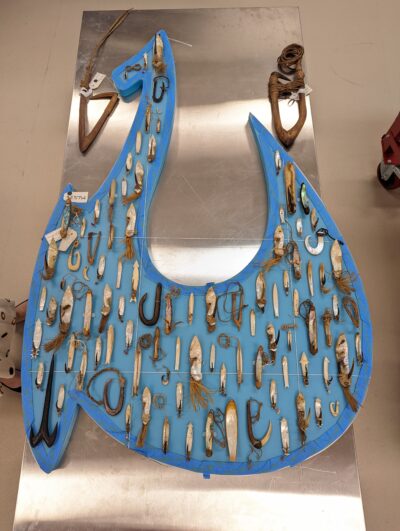
Layout for fish hook display

Kyra Kim & Heather Bleechmore sewing fish hooks
Collection Enhancement Project
Clare Kim is working on fragile skeletons from the Python family, undertaking cleaning and consolidation. Specimens were found wrapped in paper towels in zip-loc plastic bags for a number of years, after being preserved using dermestid beetles. After the treatment, specimens will be imaged and re-housed for long term storage.
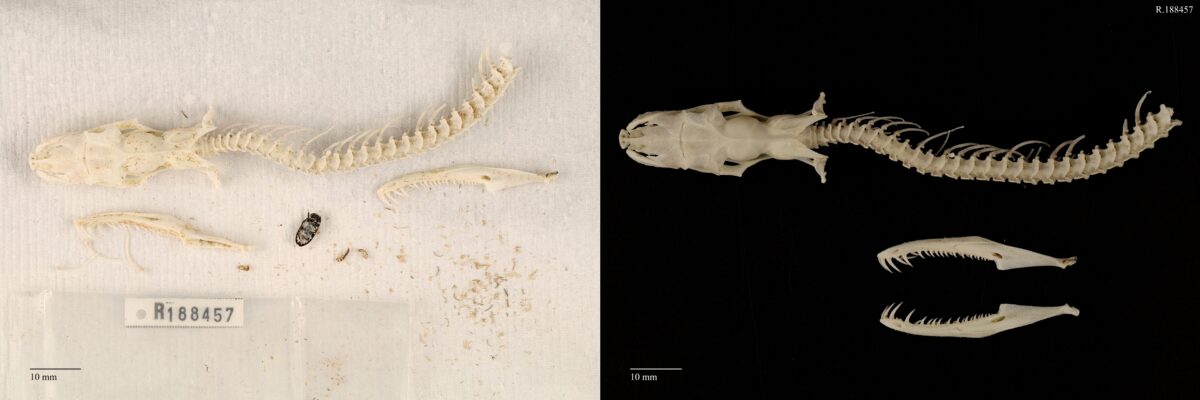
BT & AT images of a python skull – R.188457, Leiopython albertisii
Treatment Projects
Sophie Phillips is currently working on repairing and rehousing a female Strapped-tooth whale skull (Mesoplodon layardii). A large section of the bone at the back of the skull had been removed during the necropsy (to access and remove the brain). A section of the nasal bone area had broken off, and the lower jaw had broken into multiple sections. To reattach the sections of the skull 10% Paraloid B72 in acetone was used to consolidate the porous cancellous (spongy) bone, before a higher concentration of 40% Paraloid B72 in acetone was used to adhere the cut section and the damaged section of nasal bone in place. Work continues to reattach the lower jaw sections.
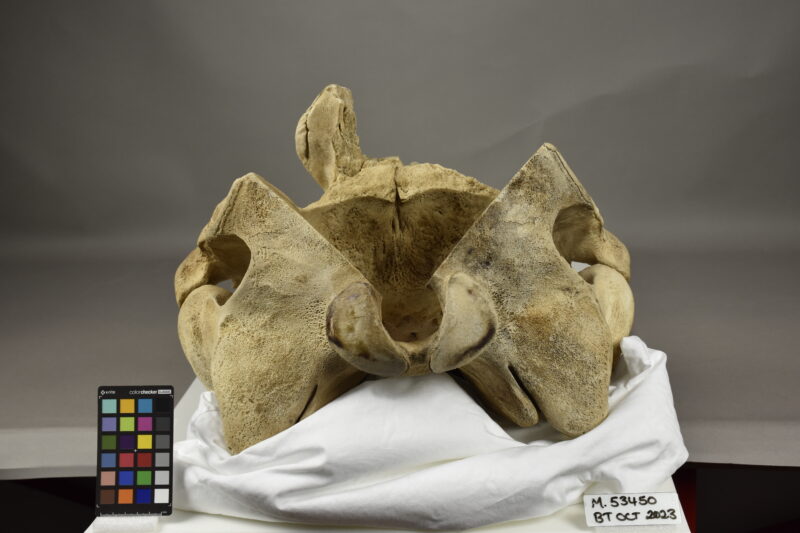
Before treatment image of whale skull. View from the back of the skull with cut section removed and the area of missing nasal bone at the front of skull visible.
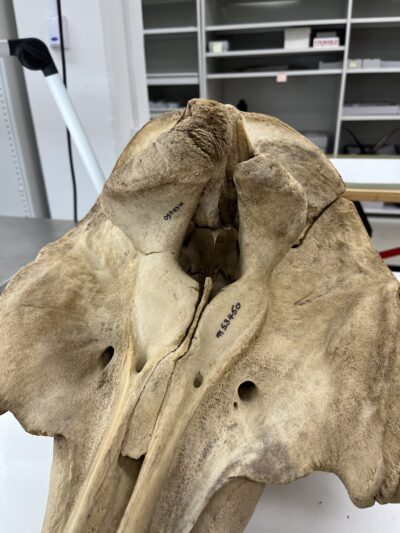
Front image of the whale skull during treatment with cut section and nasal bone section reattached.
Sheldon worked with Sophie to relax and reshape a very rare and endangered Sunda clouded leopard (Neofelis diardi) flat skin. The skin was unfortunately tightly folded in storage and was impossible for researchers to access. Gentle humidification in a chamber and light weights helped to improve access to this specimen. The Sunda clouded leopard is distinct from the mainland Clouded leopard (Neofelis nebulosa), with darker fur and smaller cloud pattern.
ACMI
Registration and Collections teams merge
After 14 years, ACMI said goodbye to Collections and Preservation Manager Nick Richardson and welcomed Sarah Caldwell in the new role of Head of Registration and Collections. Sarah has been at ACMI for some time, but this role sees the Collection and Registration teams merge to form a new super team! We also said goodbye to superstars Megan Taylor (Assistant Registrar) and Linda Connolly (Vernon guru) and welcomed the exceptional Sarah Brown to the team, as the Registrar of Exhibitions and Commissions.
ACMI exhibitions
ACMI’s exhibition schedule has been jam packed this quarter, as we installed and then de-installed Goddess: Power, Glamour, Rebellion and Two Girls Amoonguna by Sally M Nangala Mulda and Marlene Rubuntja. Currently on display are Angela Tiatia’s The Dark Current and two web-based artworks on our Gallery 5 platform – Minyak Sawit Keluarga (Palm Oil Family) by Olivia Koh and We are Gods by Emile Zile – as well as the newly opened Works of Nature by Marshmallow Laser Feast. All of the newly commissioned works listed are also acquisitive to ACMI’s Collection.

ACMI Registration team and Museum textile specialists Laure Weir and Laure Cerbelaud de-installing ACMI’s Goddess exhibition. Image credit Sarah Brown.
Registration
In August our Exhibitions and Commissions Registrar, Sarah Brown, participated in the four-day workshop Changing Climate Management Strategies, co-organised by the Getty Conservation Institute and the National Gallery of Victoria.
Through a series of structured presentations, hands-on workshops, demonstrations and robust discussions, the participants were presented with the obstacles in developing and implementing more adaptive environmental management strategies in museums and how they could become advocates for change within the boundaries of their own institutions. As a result of the findings and outcomes from the workshop, the ACMI Registration and Collections team is aiming to implement an impact and feasibility study on the environmental conditions and settings for the next major temporary exhibition.
Research
A minor thesis paper by Ben Abbott: ‘De-shrinking cellulose triacetate: vapour chamber methods to aid preservation of decomposing motion picture film’
Ben Abbott, Digital Preservation Technician, recently completed a minor thesis as part of the Master’s program at The University of Melbourne’s Grimwade Centre focusing on degradation of cellulose triacetate (CTA) motion picture film. Shrinkage and distortions occur commonly in CTA film, caused by plasticiser loss and vinegar syndrome. This preliminary research included experimentation with a ‘de-shrinking’ technique, designed to temporarily reverse the degradation effects. The study examined the viability for this technique to aid the digitisation of films with advanced degradations.

Degraded 16mm cellulose triacetate film samples, ‘de-shrunk’ (above) and original state (below), documented as part of ‘De-shrinking cellulose triacetate: vapour chamber methods to aid preservation of decomposing motion picture film’, a minor thesis paper by Ben Abbott. Image credit Ben Abbott.
Collection
Welcoming speakers and guests from all over the world, ACMI hosted the Born Digital Cultural Heritage Conference with Swinburne and RMIT Universities from 29 November to 1 December. Keynote speakers included Melanie Swalwell, Dragan Espenschied and Sean Cubbitt, and the conference also provided an opportunity to launch the Archiving Australian Media Arts (AAMA) paper , which draws together all of the work conducted over many years by Swinburne, RMIT, ACMI, AGNSW, Library of SA and Griffith University as a part of the AAMA ARC. ACMI has also created an online exhibition for some of the work done in the AAMA project: https://www.acmi.net.au/stories-and-ideas/archiving-australian-media-arts/ where visitors can interact with legacy works from the 1990s onwards via the Emulation-as-a-Service (EaaSI). Read about how we did this on ACMI Labs if interested.
Seb Chan, Lucie Paterson, Indigo Holcome-James and Candice Cranmer presented papers at the National Digital Forum at Te Papa Museum in Wellington in November on subjects such as AI in the museum sector, digital states of play and embedding the EaaSI infrastructure into ACMI’s website. Candice Cranmer also presented alongside Leive Baetens (NISV), Dragan Espenschied (Rhizome), Gaby Wijers (LIMA) and Jack McConchie (TATE) in a conversation about Immersive Media Preservation in October as a part of Leive’s research paper: ‘Collaboratively Moving Forward, Exploring Strategies for the Selection and Preservation of Immersive Media in Cultural Heritage Institutions’.
Grimwade Centre for Cultural Materials Conservation (Academic Programs and Grimwade Conservation Services)
The second part of the year was a busy one with many of us travelling for conferences, research, training and workshops, and renewing contacts with our visiting scholars and experts.
ICOM-CC in Valencia
In September, Team Leader of Objects, Archaeology, and Textiles Dr Holly Jones-Amin, Graduate Intern Larry Edwards and Dr Nicole Tse attended ICOM-CC in Valencia, Spain. Holly had a particularly busy speaking week. She delivered two papers: ‘The Sustainable Conservation of Loong, the oldest processional dragon’ into the Indigenous Objects and World Cultures Working Group and ‘How studying ethnographic accounts of pottery firing assists in determining deterioration in low-fired pottery’ from her doctoral research to the Archaeological Materials and Sites working group. As an assistant coordinator of this group, Holly with Leslie Freeman from the Getty Conservation Institute, chaired this session. The working group had a great turnout with a variety of papers on everything from archaeological shelters to VOCs from mummies. While alumni Rosie Cook and Nicole Tse also joined the Indigenous Objects and World Cultures Working Group to present a paper on ‘Ontology and knowing: A framework for conserving a rare musical instrument within and beyond the archive’, resulting from a long-term collaboration with the Music Archive Monash University (MAMU), Professor Margaret Kartomi, Luqmanul Chakin and the #bundengan project.
We were delighted to cross paths with over 700 delegates, renew and meet new contacts including well-known author Professor Salvador Muñoz Viñas, who was the conference co-ordinator. Larry was introduced to the academic and practical world of textile conservation, with two highlights being the research of the styles of archeological costumes during restoration by Shujuan Wang in China and a visit to the extraordinarily resourced Institut Valencià de Conservació, Restauració. They were both delighted to attend a concert by the students of the Conservatori Superior de Musica ‘Joaquin Rodrigo’ at the beautifully conserved baroque church of San Nicolas, one of the many cultural jewels in the Spanish city of Valencia. Preprints from past conferences are open access https://www.icom-cc-publications-online.org/ and the 2023 preprints will be accessible to all in 2024.
Professional development – China
In October, Textile Conservator Reyhane Mirabootalebi visited China for an intense two-week trip that was prompted by a number of Chinese textile artefacts coming to the textiles lab for conservation treatments. The items range from intricate embroideries on silk to Chinese calligraphy silk scrolls. This sparked an interest as well as a need for learning about the Chinese traditional and modern conservation philosophy, methods, and materials. This was also to ensure culturally appropriate approaches are adopted for preserving Chinese textiles artefacts and relics. China is known to be the birthplace of silk fabric and home to the world’s most sophisticated, intricate weaving techniques. Silk textiles were amongst the finest and most desirable fabrics globally with silk itself serving as a significant geopolitical commodity for centuries. Reyhane’s journey took her through various provinces, where she visited the conservation and research labs at several institutions such as Heritage Conservation, the Northwestern Polytechnical University (Xi’an), the Shaanxi History Museum (Xi’an), the Cultural Relics Technology and Science (Xi’an), the conservation department at Xiamen University (Xiamen), and the collections and conservation labs at the Chinese National Silk Museum (Hangzhou). The experience was unique, and an opportunity to explore some parts of this ancient, beautiful country while gaining some insights into the diverse and advanced state of conservation research at various institutions. She hopes this to be the beginning of a long-lasting collaboration, fostering a two-way exchange of knowledge and experience with her Chinese colleagues (see image). Nicole also visited Xiamen University and we thank our host Prof. Zhanyun Zhu and graduate student Yalng.
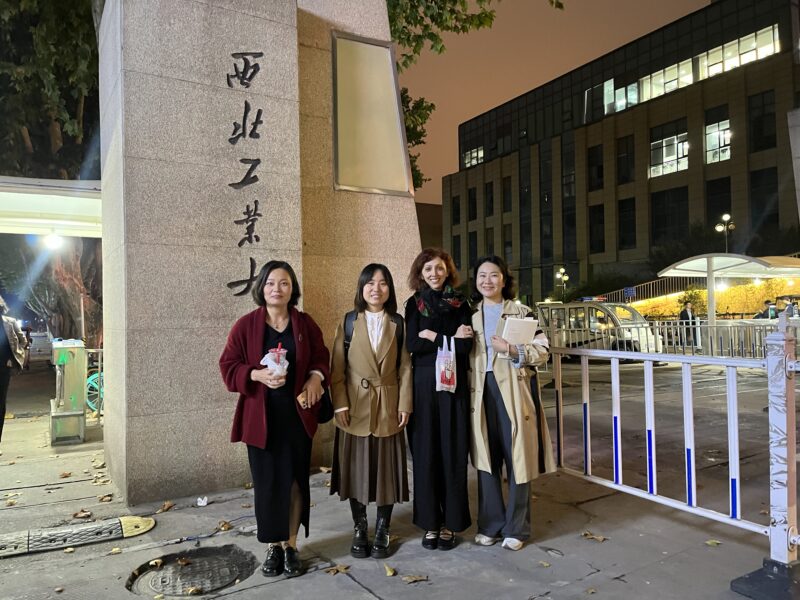
Dr Reyhane Mirabootalebi with Dr Yang Huan, Dr. Jingnan Du, and Dr Jiaojiao Liu. The Northwestern Polytechnical University, Xi’an, October 2023.
Professional development – Italy
In September, Painting Conservator Caroline Fry was fortunate to be included in the Attingham Trust program Palladio and The Veneto. The program was a 10-day residential ‘immersion’ into the history of buildings in Venice and the Veneto with a focus on those built by Renaissance architect Andrea Palladio. Caroline joined 30 other participants from the UK, Europe, India and the United States.
The course included lectures, site visits to private homes and access to various collections housed in Venice and the Veneto. Highlights of the course were an evening tour of the grounds and interior of Villa Almerico-Capra, known as Villa Rotunda, hosted by current owner Count Nicolo Valmarana. Another highlight was a tour of Villa Valmarana ai Nani, constructed in 1669. The interior houses fresco cycles by Gianbattista Tiepolo and his son Giandomenico. No lecture or digital image can compare to the experience of traversing the grounds, exploring the rooms and enjoying the vistas while accompanied by international experts and the owners of these extraordinary buildings.
The Attingham Trust has been offering intensive ‘study tours’ of historic houses for over 70 years. The aim of the courses is to provide a comprehensive examination of the architectural history, landscape, gardens, interiors, and collections of historic houses. Courses are attended by mid-career curators, conservators, architects, artists and allied professionals. Australians can find out more about the courses by contacting Attingham Trust directly at www.attinghamtrust.org and refer to Copland Foundation www.coplandfoundation.au for financial support and scholarships.
Getty Conservation Institute – ‘Changing Climate Management Strategies’ workshop
In August, Noni Zachri attended the Getty Conservation Institute’s ‘Changing Climate Management Strategies’ workshop along with master’s student Camille Calano, Claudia Husband and Kit Wong, held at the National Gallery of Victoria. This workshop brought together 40 collections care professionals from across the Asia-Pacific region to discuss different strategies for managing collection environments, sustainability and to learn about acoustic emissions (AE) monitoring as a tool for assessing real-time mechanical responses of objects to changes in the environment. A short seminar program was also presented by the Getty Conservation Institute at the University of Melbourne, and we thank Vincent Laudato Beltran, Alexandra Bridarolli, Michał Łukomski and Celia Winter for sharing.
IRUG 15th International Conference, Tokyo
In September, PhD candidate Seka Seneviratne presented a poster on the ‘Preliminary FTIR-ATR analyses coupled with SEM-EDX for the identification of microbes on Laboratory made modern paintings from Thailand’ to the Infrared users Group. Paula Dredge and Nasim Koohkesh also joined the conference, which included 35 oral presentations, 13 posters and a keynote by Dr James de Haseth on reflectance mode infrared spectroscopy,
AICCM 50+/-50
It was wonderful to see everyone at the AICCM 50+/-50 Conference in Canberra. Thank you to the organising committee and Alice Cannon for steering the program and ensuring it was the celebratory event the AICCM deserves. We also welcomed three awards, the AICCM Medal awarded to Professor Sloggett, the 2023 Outstanding Conservation Project of the Year awarded to Grimwade Conservation Services for their Flood Recovery Project, and the ADFAS Student of the Year awarded to Jo Lupgens. Robyn, Paula, Nicole, Sabine Cotte and Holly presented papers, and it was a delight to see recently awarded Dr Cancy Chu (https://blogs.unimelb.edu.au/shaps-research/2023/10/30/cancy-chu/) present her research on tear repairs of laminated papers supported by her Fullbright Scholarship. Congratulations Cancy.
Visiting scholars from Thailand
From August to November, we hosted visiting scholars Asst Professor Sutinee Girdthep and Researcher Titichaya Limpathompipop from Silpakorn University. They joined our teaching program and also carried out some research on Thai mural painting binders with Nicole and master’s student Supansa Thongsuk.
Specialist Certificate in Cross-Cultural Conservation and Heritage
After a few years, it has been a great pleasure to offer this program again. For two weeks at the end of November, five remote First Nations arts workers are studying for a postgraduate qualification in cross-cultural conservation and heritage at the University of Melbourne. This year’s participants were: Maxine Charlie of Nagula Jarndu, Broome (Kimberley); Russel Davies of Ardiol Arts, One Arm Point (Kimberley); Angelina Karadada Boona of Kira Kiro Arts (Kimberley); Rodriguez Wilson of Mamadawerre, Homeland (Arnhem Land); and Megan Yunupingu of Elcho Island Art and Crafts (Arnhem Land). This qualification, delivered through a pioneering partnership between ANKA and the University of Melbourne’s Grimwade Centre and Trinity College, is part of ANKA’s Arts Worker Extension Pathways Program. The initiative supports First Nations arts workers to care for cultural objects and heritage at their art and culture centres and on Country across northern Australia. At the end of the course, students will progress their focus projects and take back skills to help care for knowledge for future generations. The Specialist Certificate is a pathway to further study options. The partner institutions who made this program possible were Arnhem, Northern and Kimberley Artists Aboriginal Corporation (ANKA); Grimwade Centre for Materials Cultural Conservation, The University of Melbourne, and Trinity College, The University of Melbourne.
Master of Cultural Materials Conservation
Internships
Semester two has been another busy time for internships for our Master of Cultural Materials Conservation students. As many of you know, our master’s students are required to complete a compulsory three-week internship as part of their final year of studies and this year we introduced a second internship elective subject, giving them the option to add-on another three weeks to their placement. This semester, students have completed placements at: Art Gallery of NSW; Australian National Maritime Museum; Book Conservation Services – Karen Vidler and Associates; Canterbury Museum; Christchurch Art Gallery Te Puna o Waiwhetū; Grimwade Conservation Services; Lembaga Pembangunan Seni Visual Negara National Art Gallery, Malaysia; Melbourne Holocaust Museum; Naturhistorisches Museum Wien, Austria; Noemi Penela Resturacion y Conservacion, Spain; and Queensland Art Gallery | Gallery of Modern Art. We’d like to take this opportunity to thank these and all of our generous internship hosts for 2023. All the Grimwade academic team really appreciate their commitment to developing the next generations of conservators and it is always a great pleasure to read about the projects our students have had the opportunity to contribute to.
In June, the Grimwade Centre hosted a special Family and Friends Event in collaboration with Student Conservators at Melbourne, with more events planned to mark its 20-year anniversary (stay tuned). A group of students – Jo Lupgens, Supansa Thongsuk, Wing Yi Ching and Jenna Harburg – also finalised the treatment of Virginia Cuppaidge’s Cytheria, a large-scale 196 x 606 cm painting, which was exhibited at the Sydney Contemporary Art Fair, as featured in Artguide, and Artlink Magazine. Alumni also contributed and thank you.
Finally, this year a full program of master’s students presented and completed their minor theses in October. Topics ranged from sustainability, plastics, time-based media, conservation in community and knitting to gel cleaning. Congratulations everyone for demonstrating commitment to your topic and producing some important research.
ICS Melbourne
Although the year is coming to an end, the ICS Melbourne team has been ramping up on a number of large-scale projects that will keep everyone busy well into the new year. We’ve also experienced an influx of smaller artworks and objects coming into the lab for treatment, including textiles, ceramics, metals, stone, paintings and paper.
Bronze lobster
Zora Sanders worked on a delightful (though unnervingly lifelike) Japanese bronze sculpture of a lobster. The treatment involved repairing some broken elements on the creature’s abdomen and fabricating a new antenna to match the lobster’s one remaining appendage, before repatinating and waxing. Each part of the lobster was articulated separately—so aside from looking life-like it also moved very realistically. Zora can confirm that several members of the Melbourne team were given a real shock when they saw it on the lab table out of the corner of their eye.

Lobster before treatment.
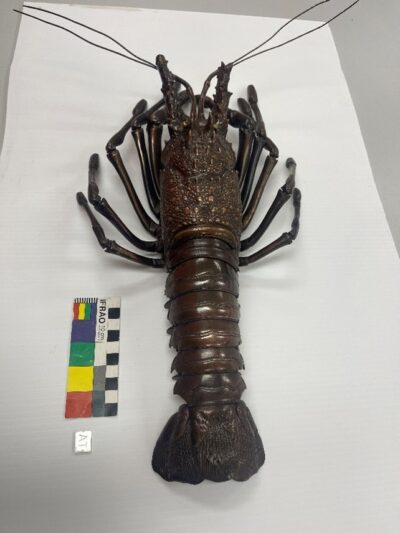
Lobster after treatment.
Sunday Morning, 1982
Eden Christian restored Alexandra Obarzanek’s Sunday Morning, 1982, for the Finklestein Gallery after it suffered significant liquid damage. The artwork was in poor condition, with several drip marks on the surface and loss to the paint media. The artwork was also affected by minor abrasions across the itrs face and its frame.
The ‘before’ and ‘after’ images demonstrate Eden’s deft restoration. The artwork will be returned to the gallery for display.
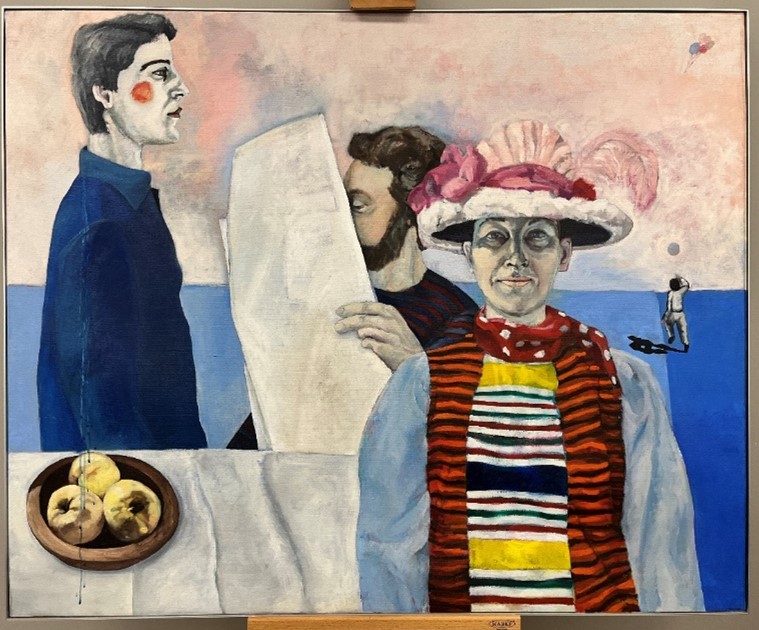
Sunday Morning – before treatment.
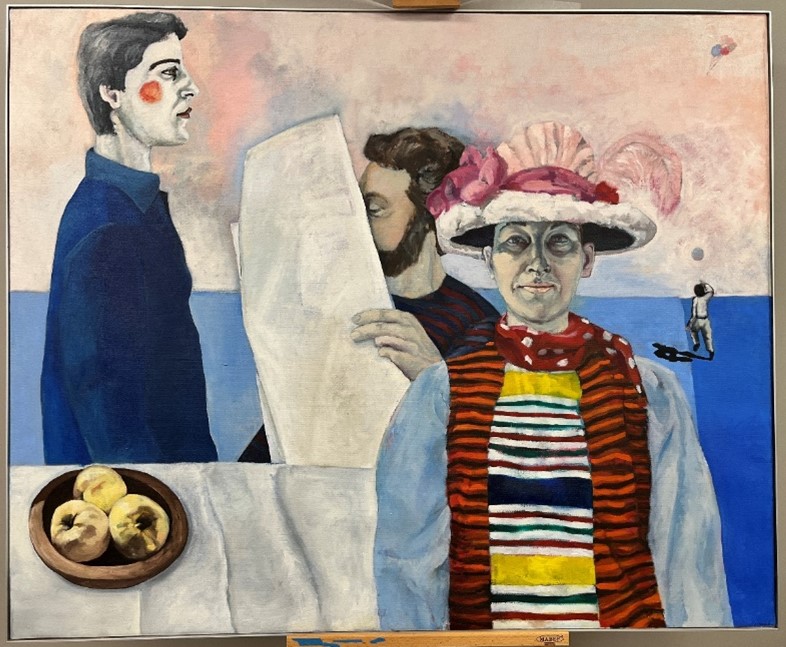
Sunday Morning – after treatment.
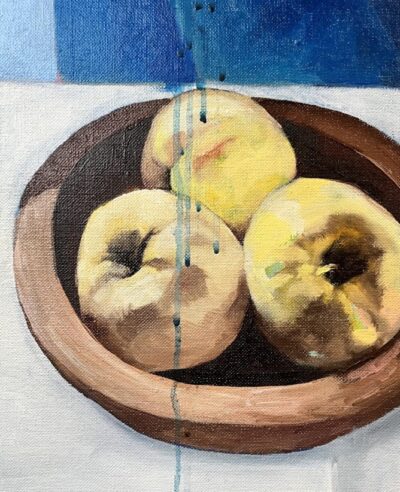
Sunday Morning – detail of apples before treatment.

Sunday Morning – detail of apples after treatment.
Thanjuvar painting conservation
Eden is currently breathing new life into an early period Thanjuvar artwork of a Hindu deity for a private client, which was damaged in transport during their family’s relocation to Melbourne. The painting itself is highly detailed, with gilding, and the border is inlaid with clear cabochons. The frame will also receive treatment.
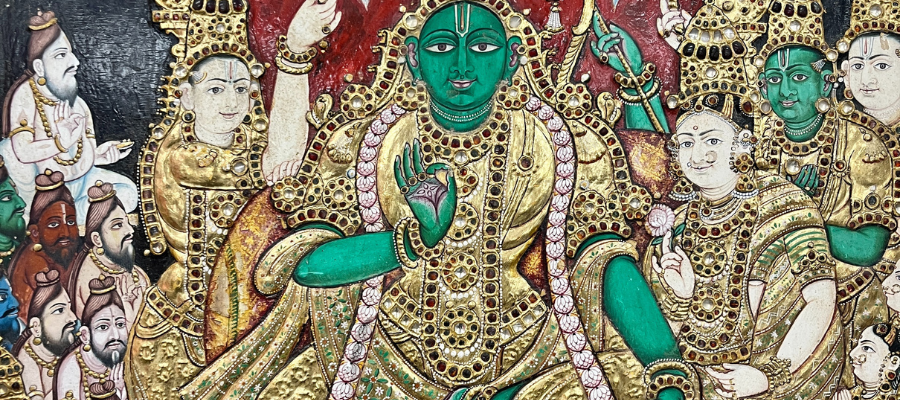
Thanjuvar painting before treatment.
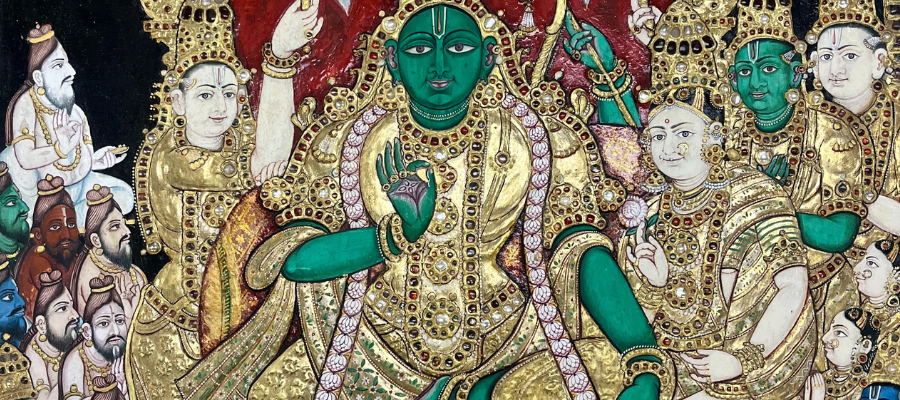
Thanjuvar painting after treatment.
Anoxic pest treatment
There has been an influx of items requiring anoxic pest treatment this quarter! This is often a safer alternative to eradicating pests, fungi or bacterial infestations from objects.

Anoxic pest treatment.
Fitzroy Gardens Fairies Tree and Scarred Tree ongoing maintenance
As part of our ongoing relationship with the City of Melbourne, Zora, Eden and Toni Sampson have been on site undertaking maintenance of Ola Cohn’s Fairies Tree at Fitzroy Gardens. The tree had significantly deteriorated since it was last inspected in June, and displayed considerable loss of the carvings, cracking and lifting of the decorative surface. A large part of this round of maintenance involved filling and consolidating the cracks and losses in the tree, particularly around the hollow. The deteriorated carvings were reconstructed by Zora and Eden, with the artwork being inpainted with acrylic paint as required. The tree is also being treated with a wood oil to encourage water run-off to help mitigate wood rot and other water damage.
Similar works were also undertaken to preserve the Fitzroy Gardens Scarred Tree.
New staff member
Our Melbourne team is thrilled to introduce our new Paper Conservator, Rebecca Clendinen. Rebecca trained at Queens University (Ontario, Canada), graduating with a Master of Science (Art Conservation), and joins ICS after undertaking recent internships in Australia. Rebecca specialises in paper conservation and has dived headfirst into a number of paper-based treatments.
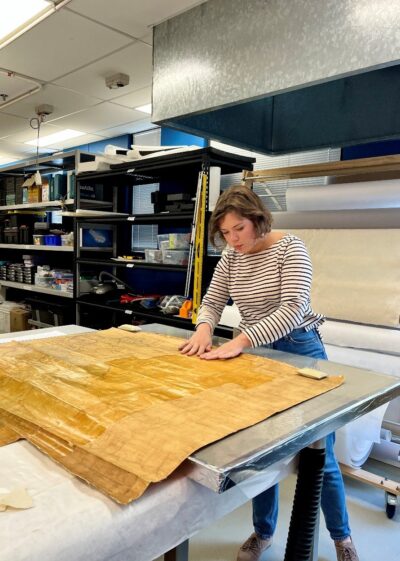
Paper Conservator, Rebecca Clendinen.
Conferences
Zora and Eden were among the ICS crowd in attendance at the annual AICCM conference held in Canberra in November. They returned to Melbourne buzzing with news from the conference, and keen to share the insights gained with the rest of the team.
In September, Katie Smith attended the ICOM-CC Conference in Valencia, with Julian Bickersteth, Matteo Volonte and Alis Jitarescu. Julian presented a paper on learnings from the Lismore floods and Alis, Suati Rojas and Katie Wood presented posters.
National Gallery of Victoria
Michael Varcoe-Cocks, Associate Director, Conservation, has been busy in his role on the steering committee of the design team for NGV-C. As part of the NGV-C developments, the department has been preparing for the relocation to a temporary space on-site at NGV-I to take place in early 2024 for the duration of the NGV-C build. Conservation Project Assistant, Manon Mikolaitis continues to assist with the collection management and preservation planning of the NGV’s time-based media collection.
Michael, together with MaryJo Lelyveld, Manager, Conservation, Caitlin Breare, Conservator of Paintings, and Rahila Merchant, Conservation and Collections Project Assistant, delivered a four-day workshop co-organised with the Getty Conservation Institute (GCI) entitled ‘Changing Climate Management Strategies’. With over 50 practitioners from Australasia, South Asia, Southeast Asia, and East Asia in attendance, the workshop addressed obstacles in developing and implementing more adaptive environmental management strategies in museums.
MaryJo and Genevieve Sullivan, Conservator of Indigenous Art, travelled to the Warnayaka Art Centre in Lajamanu, Northern Territory, to meet with members of the Warlpiri Community and consult with relatives of the artists whose paintings are being treated as part of the Bank of America Art Conservation Project. This trip also allowed for networking with individuals who regularly care for Indigenous art and First Nations artists, which will help to inform the development of a framework for First Nations art preservation.
MaryJo also travelled to Canberra for the AICCM 50+/-50 National Conference, co-presenting a session on sustainability, along with colleagues Suzi Shaw and Bella Lipson-Smith. All members of the department have been busy co-ordinating conservation activities around the de-installation of Melbourne Now, and the installation of the forthcoming NGV Triennial 2023.
Paper and Photographs
The NGV Paper and Photographs team has been hard at work on a number of fronts. In April 2023, the NGV received a generous donation of a series of works by Robert Rooney. The bequest includes many prints, drawings and a selection of the quirky Spon artist books. Recently, Bonnie Hearn has completed treatment of Rooney’s gouache painting Untitled (Repeating pattern with childhood motif), ca. 1954–1956. For this particular work on paper, Rooney had mounted the gouache with a custom-made blue-painted window, adhered to the verso with pressure-sensitive tape. Over time the tape had disintegrated and failed, while the window mount had torn and partially separated from the gouache. Conservation treatment involved drycleaning, tape removal, repair, consolidation and retouching, giving structural and visual integrity back to the early graphic work.
Irena Zdanowicz has written an online catalogue raisonné of Bea Maddock’s late works (from 1984 on), which is soon to be published by the University of Melbourne. As part of the project, Louise Wilson has written an essay on Maddock’s papermaking practice. Louise’s research greatly benefitted from the papermaking expertise of Helen McPherson who taught her the intricacies of Hollander beater operation and many aspects of hand papermaking at the Papermakers of Victoria studio in Bundoora.
In preparation for the forthcoming Triennial 2023 display, Ruth Shervington has liaised with the artist Hoda Afshar on her system to display 950 gelatin silver photographs. The photographs will be wall-mounted on narrow shelves top and bottom with distance between photograph and wall. This group of photographs is one component of the project created by Afshar, the other components including a time-based media work and a set of six large glass panels printed upon and with a mirror effect.
Paintings
The NGV Paintings conservation team has been balancing its regular work program with preparations for this year’s Triennial exhibition, in terms of both installing paintings and being on standby to help other sections as the workload ramped up during the installation period. Raymonda Rajkowski contributed to the planning process for one section of the Triennial and oversaw the stretching of the large canvas Ngangkari Ngura (Healing Country) by Betty Muffler. In November, Raymonda was sent to Paris to condition check the large Ron Mueck sculpture Mass, made up of 100 large-scale resin sculptures of the human skull, before it travelled to the next venue in Milan. Raymonda has continued the second of three major conservation treatments of Peter Upward’s large circular canvases.

Raymonda and Caitlin stretching Ngangkari Ngura (Healing Country) by Betty Muffler. Image credit Carl Villis.
Raye Collins oversaw the preparations for the re-fitting of the permanent collection at NGV Australia following the closure of Melbourne Now. Raye is now carrying out treatments for paintings by Ralph Balson and Grace Crowley for the upcoming exhibition devoted to those artists in May 2024.
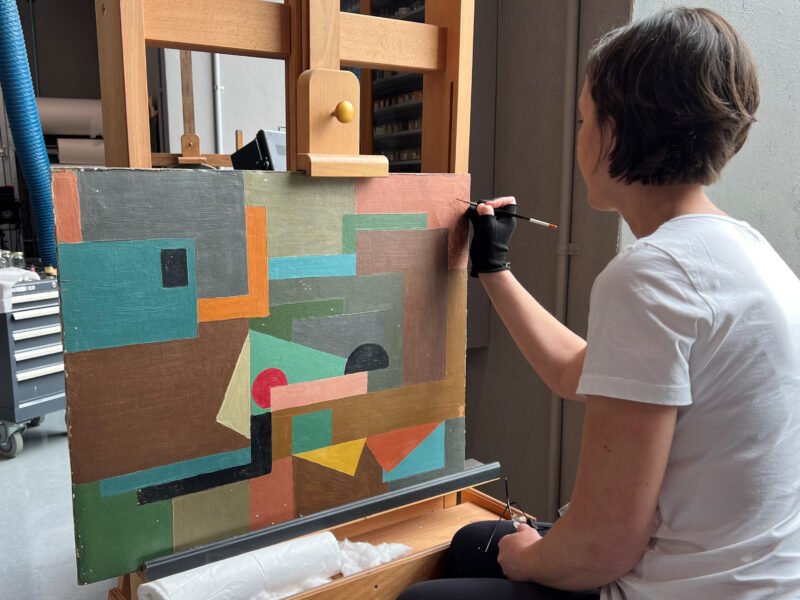
Raye Collins treating Constructive Painting by Ralph Bonson. Image credit Carl Villis.
Caitlin Breare has been performing duties as a member of the Technical Committee for the 2024 IIC Congress in Lima, Peru, for which she is also co-author of a paper detailing the NGV-GCI collaborative project on collection environments. She has also recently completed treatment of A man taken ill by LS Lowry. Caitlin and Carl Villis have also been carrying out research into digital radiography of paintings and other works of art, which they will look to publish in the next year.
Carl has commenced conservation treatment of a new acquisition by François-Hubert Drouais, an oval portrait entitled Madame d’Angot (1772). In early November, Carl travelled to Canberra to stretch and oversee the installation of the NGV’s eight-metre-long canvas by Emily Kam Kngwarray, Anwerlarr anganenty (Big yam Dreaming).
Textiles
The Textiles conservation team comprised of Skye Firth, Bella Lipson-Smith, Kate Douglas and Julia Spizzica has been particularly busy with the installation of Triennial works. Additionally, the team completed a major conservation treatment of the first half of the 17th century crewelwork bedcurtains gifted to the NGV in 2018 by the Murdoch Foundation, which involved the stabilisation and securing of the crewelwork elements onto a new ground of historically accurate twill linen.
Frames and Furniture
August saw the completion of the major frame treatment for the very large painting The Pilgrim Fathers: Departure of a Puritan family for New England by Charles Cope and it’s display in the gallery. The treatment commenced back in early 2020 and was delayed first by COVID-19 lockdowns and then due to other more pressing projects. The frame treatment involved the work principally of Bella Lipson-Smith, Dominic King, Jennifer Parker, contract assistant conservators, and Holly McGowan-Jackson, Senior Conservator. Major aspects were repairing extensive losses to the ground layers and timber, and replacing large sections of missing compo corner ornament (of which there was no complete example). Cleaning was undertaken of the highly soiled original glue coating on the bottom member using Nanorestore Peggy Gels. Jason King, NGV Frame maker, made a new slip and developed a system of joining the frame members that allows the frame to be assembled and disassembled without causing stripping of the screw holes in the soft Oregon timber.
Another long-term project that has come to completion is the publication on the NGV website of the Thallon ledger digitisation and transcription. See separate article for more details.
Suzi Shaw, Conservator, has been juggling de-installations and installations across the two sites, and rolling with the complications that lighting historic electric lamps provides. The Triennial has provided a vast array of artworks with challenges to resolve such as movement and size limitations, assembly, electrical wiring, heat buildup, tethering, etc.
Objects
Object conservators Marika Strohschnieder and Di Whittle and Decorative Arts Conservation Fellow Robyn McPherson have been busy with the preparation of works for loans to Hamilton Gallery’s Emerging from Darkness exhibition and installation of Triennial works. After 20+ years at the NGV, Trude Ellingsen has left to take up a job at Geelong Gallery as Registrar and Collection Manager. We wish her all the best in her new role and look forward to working with her and Geelong Gallery as part of the NGV’s regional outreach programs. Luckily, Georgia Harvey has stepped in temporarily to assist with some other immediate tasks.
Exhibitions
Exhibition conservators Catherine Earley, Janelle Borig and Camielle Fitzmaurice have prepared, installed and de-installed an unusually wide variety of exhibitions over the last few months including the Winter Masterpieces exhibition Bonnard: designed by India Mahdavi, which was originally scheduled for 2020; the Rembrandt: True to Life exhibition including works on paper, paintings and a cabinet of curiosities; Melbourne Now, showcasing current local artist/designer practice and installed throughout the NGV-A display building; and the NGV Triennial 2023 installed throughout the NGV-I display galleries and focusing on current international practice.
Catherine has written a survey of the Exhibitions Conservation section over the last 30 years, is writing procedure relating to virtual condition reporting, and researching internal Bizot implementation and implications for borrowing artwork.
In November, Janelle delivered a paper at Future Talks 023 in Munich. Entitled ‘Melbourne Now – a display of local innovations’, it highlighted some of the new materials currently being used by local artists/designers and starting to find their way into collections, such as algae and mycelium products as well as a potential alternative pallet wrap—a bioplastic stretch wrap made from food waste.
Camielle co-ordinated and couriered a collection-based tour to Hamilton Gallery. She took time out in August to attend the Montefiascone Study Program in Italy, focusing on book binding, and more recently attended the ICOM-CC conference in Valencia, Spain.
State Library Victoria
Collection Care
Staff changes
After 28 years at the State Library of Victoria, and 18 years in Conservation, Book Conservator Helen MacPherson retired in August. Her diligence and broad range of skills and knowledge have been a huge asset to the Library, and her presence has been greatly missed. We wish her all the best in her retirement.
In September, Ross Lowe joined the Preservation team as a Preservation Technician on a fixed term contract. Ross has certainly hit the ground running, rehousing a wide range of challenging collections and formats at an impressive pace. Having previously worked for the Library’s Collection Storage team, Ross’s insights into collection storage have proved to be immensely valuable.
In October we also welcomed back Paper Conservator Jessica McElhinney from maternity leave.
Social news

Left: Circuit board with wires and power adaptor, which interact with iPads as part of Stargazing Map (H2021.93/1-3, State Library Victoria). Image credit: Jessye Wdowin-McGregor. Right: Still from instructional video showing interaction between viewer with iPad, which formed part of the installation. Image credit: Jim Arneman.
Preservation Technician, Jessye Wdowin-McGregor published an informative two-part blog entitled, ‘Knitting, coding, and the stars: caring for a time-based media artwork in a library collection’ (part 1 | part 2) delving into the installation, documentation, display and preventive treatment of Stargazing Map (2022), a complex multimedia artwork and centrepiece of the Library’s recent popular exhibition Handmade Universe.
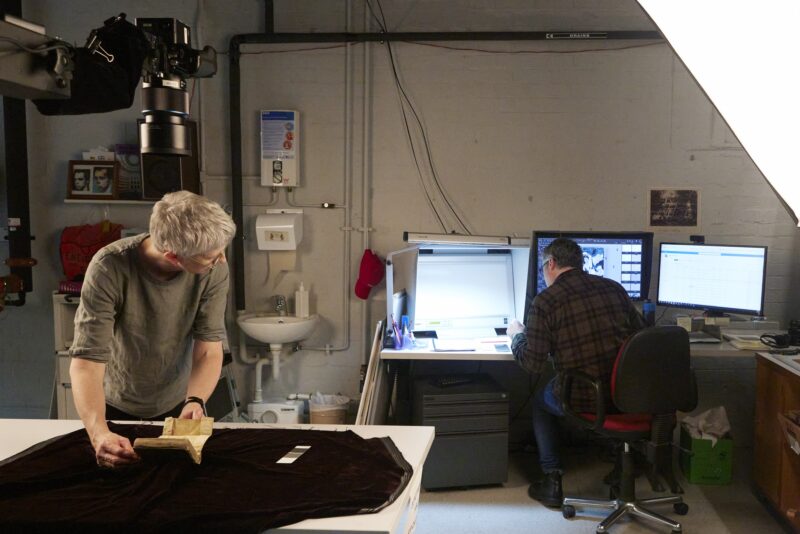
Katrina Ben gently restraining the pages of Littletons tenures in English (RAREEMM 164/11, State Library Victoria). Image credit: Anne-Marie De Boni.
Senior Book Conservator Katrina Ben and Paper Conservator Albertine Hamilton co-authored a blog post that explores the conservation work required to prepare for the Library’s first digital only exhibition, Beyond the Book: A journey through the Emmerson Collection.
Most recently, Albertine Hamilton has also published ‘Careful work for Howard Arkley’s ‘Casual Works’’, which gives a behind-the-scenes look at the considerations that go into conserving the artists’ archive and preparatory works, which were recently acquired thanks to a donation from The Estate of Howard Arkley. Be sure to check out our blogs regularly to stay up to date with all the great projects that have been taking place across Collection Care!
Treatment projects

Ned Kelly’s armour (H20171, H2001.242 & H2002.136, State Library Victoria) reinstalled in its dedicated display case in the Redmond Barry Reading Room. Left shoulder plate on loan from Museums Victoria, boot worn by Ned Kelly on loan from the descendants of the late Jesse Dowsett. Image credit: Christine Mizzi.
The Conservation team has been closely involved in the relocation of the Ned Kelly armour into its new location in the Redmond Barry Reading Room. A popular object, the move has required delicacy and collaboration across many departments in the Library and with external stakeholders.
Paper conservators Marika Kocsis, Albertine Hamilton, Katy Glen, Jessica McElhinney and Christine Mizzi have continued working through two very large collections of architectural plans, with the last 500 finally within our sights. These have included plans for various entertainment venues across Melbourne.
The Preservation team has been busy over recent months, rehousing and listing over 200 boxes of collection material for relocation to the Library’s offsite storage facility. Preservation Manager Kate Holloway, with assistance from Ross Lowe, completed a long-term project rehousing the very large (161 boxes!) Stephen Murray Smith archive. Among many other not-quite-so-monstrously-large collections, Preventive Conservator Leah Williams completed rehousing the papers of celebrated portrait painter Marion Jones (1892–1977), while Jessye Wdowin-McGregor put the finishing touches on the records of Victorian author, editor and publisher Michael Heyward.
In the world of Preservation Materials, Senior Preservation Technician George Matoulas and Preservation Technician Josh Cassidy have devised a new and improved storage solution for the Library’s collection of large-format rare pamphlets. By replacing existing boxes with updated archival enclosures, George and Josh have reduced the overall footprint and improved handling of and access to this significant material. Always looking for ways to be more sustainable, the extracted boxes are being cut down and reused as support board for fragile collection items.
Exhibitions
The Conservation team prepared material and assisted with the installation of the exhibition Luminous: A thousand years of Hebrew manuscripts, which opened on 17 October. This contains books from the British Library, the Jewish Museum of Australia, private loans and a number of books from the State Library Victoria’s David Halperin collection.
We have also started preparation for the next rotation of World of the Book. Some highlights to come are a display of recently acquired books funded through the Women Writer’s Fund and some beautiful albums with botanical specimens of seaweed and ferns, compiled from various collections across the Library.
Conference attendance
Over four days in August, Leah Williams attended the Changing Climate Management Strategies workshop at the National Gallery of Victoria (NGV), along with the Library’s Essential Services Coordinator Mick Perrotta. Co-organised by the Getty Conservation Institute (GCI) and the NGV, the workshop aimed to address obstacles in the development and implementation of adaptive environmental management strategies in cultural institutions.
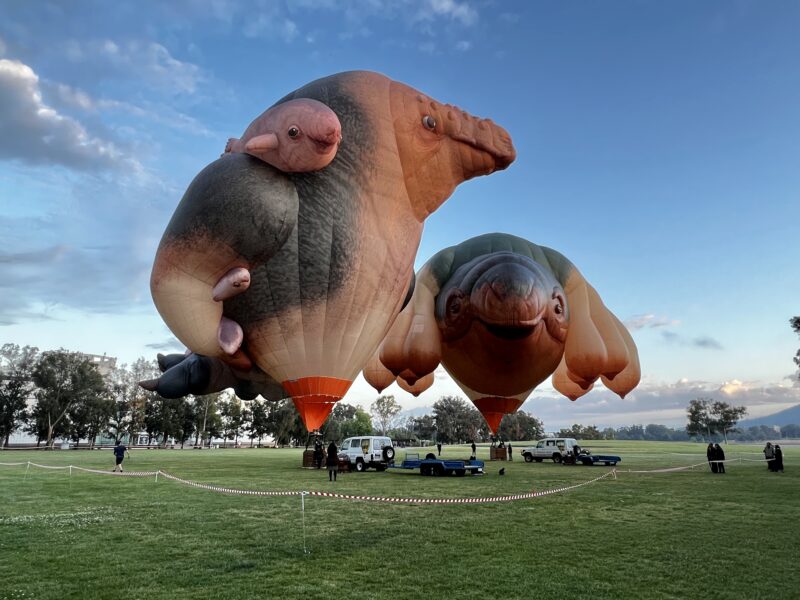
Patricia Piccinini’s Skywhales, 6am on 16 November, AICCM National Conference, Canberra, ACT. Image credit: Jessye Wdowin-McGregor.
Several of the team across Collection Care also attended the AICCM National Conference, both in person and virtually, and are excited to share their insights and new ideas across the department soon. A particular highlight was getting up early to experience Patricia Piccinini’s Skywhale hot air balloons, which are now in the collection of the National Gallery of Australia.
ICS Perth
ICS Perth has been roaming the country recently! In November, Claire Rowson worked in Canberra with the ICS Sydney team. She carried out treatments in the House of Representatives at Old Parliament House and also inspected a number of public outdoor sculptures.
In November, Claire travelled to Sydney for the annual ICS Day and took the opportunity to also visit the Museum of Fire in Penrith with our newest Objects Conservator, Karen Wilcox. Their work will inform an ongoing comparative assessment of firefighting appliances in WA.
Claire has also attended a number of conferences, including the WA State Heritage Conference in October, where Lily Bennion, Assistant Curator, Fremantle Prison, presented a paper about the ICS mural conservation work at Fremantle Prison.
Claire also represented ICS and WA at the AICCM National Conference in Canberra.
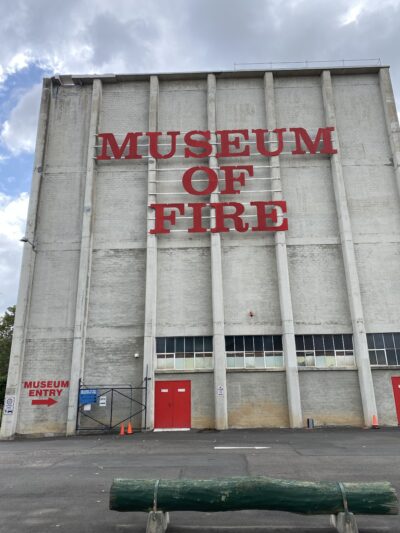
The Museum of Fire, Penrith.

Karen Wilcox at the Museum of Fire, Penrith.
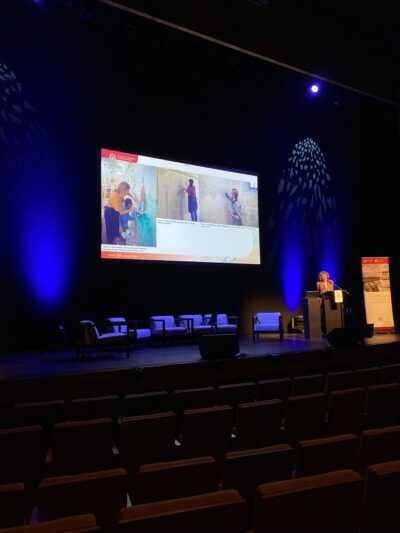
WA State Heritage Conference.
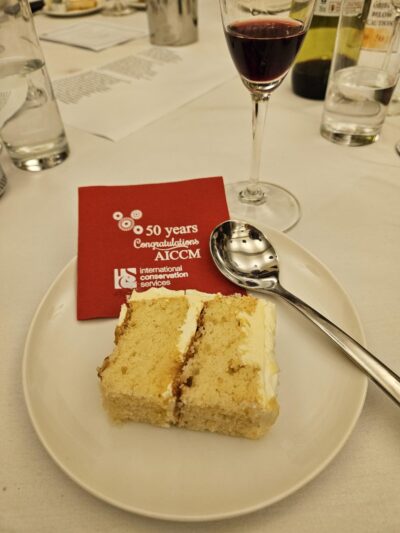
AICCM 50th birthday cake.